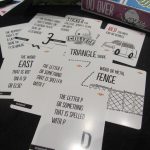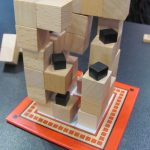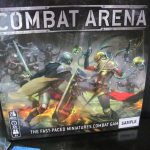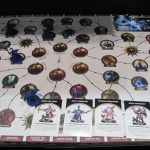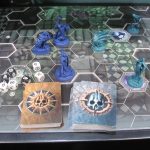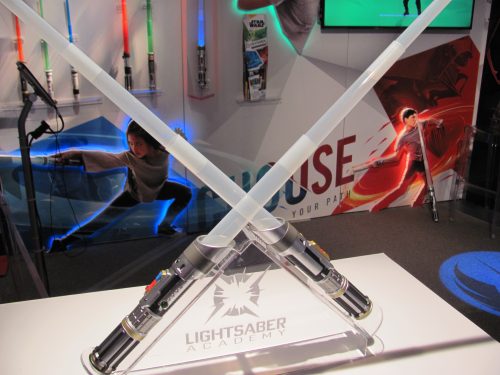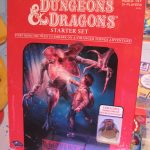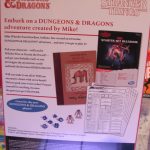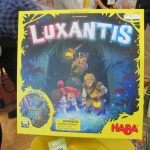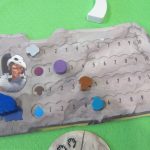 Breaking Games’s catalog is diverse, with abstracts, Euros, and party games. For me, the highlight of the bunch at NY Toy Fair was We’re Doomed ($35, March), a game that combines resource collection with a kind-of social bluffing or auction mechanism. The idea is that the players must work together to build a rocket to escape a doomed planet. They must cooperate and contribute the necessary resources to get a functioning rocket but at the same time, they compete with influence to claim available seats. Also factors in the game are a 15 minute time limit and unique abilities for each player, representing a certain type of government.
Breaking Games’s catalog is diverse, with abstracts, Euros, and party games. For me, the highlight of the bunch at NY Toy Fair was We’re Doomed ($35, March), a game that combines resource collection with a kind-of social bluffing or auction mechanism. The idea is that the players must work together to build a rocket to escape a doomed planet. They must cooperate and contribute the necessary resources to get a functioning rocket but at the same time, they compete with influence to claim available seats. Also factors in the game are a 15 minute time limit and unique abilities for each player, representing a certain type of government.
Another title, It Dies With Me ($25) has one player writing a personal secret on a slip of rice paper. Then on every turn, each player chooses a number on a die and hides it under a coffin. When all are revealed, the player with the highest unique number gets to move their token one space up the board and the player with the lowest number draws a card. The first to claim four cards or move to the end of the board claims the secret, which they get to read but then have to eat.
Trellis ($25), a more casual game. has players laying hexagonal tiles, and for each pair of matching-colored vines, one of their own flower tokens. The first to put out all of their flowers is the winner.
Hypo Thetically Fun ($20) is mostly a deck of conversation-starter cards in five categories: ponder, silly, story, imagination, and you.
Carl Spies ($15) is a set of cards with pre-set I Spy game conditions.
- Comments Off on Toy Fair 2019—Breaking Games
 Winning Moves’ latest rereleased classic is is the 1990s Hasbro title Pretty Pretty Princess ($17). Spin to move and collect all the matching colored jewelry.
Winning Moves’ latest rereleased classic is is the 1990s Hasbro title Pretty Pretty Princess ($17). Spin to move and collect all the matching colored jewelry.
New titles include the mini stacking game Kozo ($20). Each turn, a player places one 3D piece, along with with one small blocking cube. Nothing, though, is allowed over the center square of the board. Points are accumulated over three rounds based on the number of cubes making up each placed piece but forfeited for the round by a player who causes pieces to fall.
Apocalyptic Picnic ($17) is a lighthearted zombie card game, where the goal is to convert all other players’ families to undead. Bite cards do the dirty work. Food cards protect. And there are many others cards to protect family from harm, return them to the living, and other effects.
Stink Bug ($17) is a card game where all the leaf-shaped cards are thrown in one loose draw pile. The idea is to make pairs of matching colors but only one of those loose on the top can be pulled by a player on their turn. Also, sneak-bug cards allow players to steal from each other, butterflies are wild cards, and love bugs make pairs for someone else.
Toy Fair 2019—Games Workshop
21 Feb
Posted by David Miller as Miniatures, Modern Board Games, War Games
 Along with a few Warhammer 40,000 Funko Pops (due April-May), Games Workshop had on display at the company’s Toy Fair booth prototype mock-ups of three more entries in its series of introductory board games. These are expected to hit retail in the 4th quarter.
Along with a few Warhammer 40,000 Funko Pops (due April-May), Games Workshop had on display at the company’s Toy Fair booth prototype mock-ups of three more entries in its series of introductory board games. These are expected to hit retail in the 4th quarter.
Combat Arena ($40) is a prequel to Warhammer Quest Blackstone Fortress and is similar in complexity to this past year’s intro game, Space Marine Adventures. This one is a dueling game representing a training scenario for one to four characters (one for each player but a total of five are included). Eventually, rules will be provided for integrating Combat Arena characters in to Blackstone Fortress.
Storm Vault ($45) is a cooperative adventure game in the Age of Sigmar for up to five players. The goal is to find the three keys required to unlock the vault. Every location on the board has a corresponding card, face down along the edge. When a hero stops in a location, the player flips the card, revealing either a key or some other possible benefit. Every turn, the players will also draw chaos cards, spreading foes around the board. Chaos foes are represented by cardboard tokens but for heroes there are Age of Sigmar minis, each with its unique special abilities.
Warhammer Underworlds Dreadfane ($50) is a trimmed down but compatible version of Underworlds. It has predefined objectives and no magic.
- Comments Off on Toy Fair 2019—Games Workshop
 Lightsaber Academy, one of Hasbro’s offerings for Star Wars Triple Force Friday in October, allows kids to train as Jedi with their choice of master. A switch hidden in the hilt selects between several iconic characters, such as Yoda and Obi-Wan Kenobi, with matching changes to the toy’s color and audio instructions.
Lightsaber Academy, one of Hasbro’s offerings for Star Wars Triple Force Friday in October, allows kids to train as Jedi with their choice of master. A switch hidden in the hilt selects between several iconic characters, such as Yoda and Obi-Wan Kenobi, with matching changes to the toy’s color and audio instructions.
The lightsaber’s audio and motion-sensor technology guides a user through a variety of training exercises and when connected by Bluetooth to a local mobile device can track and display performance. Progress also advances in a head-to-head game available when two lightsabers are connected.
Information, though, is stored in the toy, so that a player’s ranking carries with them when they visit a friend’s house and connect to a different device.
At release, a single lightsaber will retail for $50.
- Comments Off on Toy Fair 2019—Star Wars Lightsaber Academy
Toy Fair 2019—Stranger Things Games
20 Feb
Posted by David Miller as Electronic Games, Modern Board Games, RPGs
 Presented by Hasbro at New York Toy Fair were three Stranger Things games coming to retail at the beginning of May.
Presented by Hasbro at New York Toy Fair were three Stranger Things games coming to retail at the beginning of May.
Stranger Things Back to the 80s Trivial Pursuit ($20) includes questions about the show and 1980s pop culture. It also features a board that flips to an alternative movement track representing the Upside Down. When a player’s piece lands on a portal, they’re all sent to the Upside Down, where it’s possible to lose a wedge.
A Stranger Things Dungeons & Dragons Starter Set ($25) includes essential rules, dice, two Demogorgon plastic figures (one painted, one not), an adventure book, and character sheets representing those played in the show.
The Stranger Things Palace Arcade console ($30) is a working miniaturized arcade-style video game system with 20 classic titles (such as Pac-Man and Galaga) and 16 more based on the show.
- Comments Off on Toy Fair 2019—Stranger Things Games
 A publisher I often recommend for games with young children, HABA’s new offerings this year at New York Toy Fair did not disappoint, and even included one with some interesting strategic choices to challenge adults.
A publisher I often recommend for games with young children, HABA’s new offerings this year at New York Toy Fair did not disappoint, and even included one with some interesting strategic choices to challenge adults.
Luxantis ($50, spring) is a labyrinth puzzle with a lighted board, memory element, and tower defense section. Players roll the die and press the matching button to light up spaces on the board. Blue spaces are safe. Red spaces send pieces back to the start. Landing on the right spaces allows players to collect artifact used to defeat monsters as they move up another board attacking the castle.
Snail Sprint ($29, now) is a racing game, where players share the racing snails, scoring points (3 points for first place, 2 points for second place, 1 point for third place) only for the snails shown on their card. Each turn, a player rolls two dice and picks a snail color from one die and destination shape from the other. If a snail lands on top of another snail, the one underneath is trapped. Appropriate for snails climbing trees, though, the path of movement also includes the outer edges of the game box—the box is a tin and the snail pieces have magnets.
Honga ($50, March) is a strategic game of survival. The goal is to collect enough food and water, while keeping the tiger from stealing them. When placing the game’s round cards, players have a choice of orienting the printed hand symbols either toward the resources they need to collect or toward the tiger to keep it at bay.
- Comments Off on Toy Fair 2019—HABA
Trending
- Massdrop.com
- Oh the Irony—Illuminati Card Game Continues to Inspire Conspiracy Theorists
- Home
- Footprints, an Educational Ecology Game
- USPS Adds Board Game Flat Rate Box
- Baila, the Estonian Drinking Card Game
- Crystal Caste Wins Dice Patent Suit Against Hasbro
- Mirror Game, Red and Blue
- Are Board Games Dangerous?
- The Truth About Dominoes On Sunday in Alabama
Archives
Most Popular Articles
- Oh the Irony—Illuminati Card Game Continues to Inspire Conspiracy Theorists
- The 20 Most Valuable Vintage Board Games
- The Truth About Dominoes On Sunday in Alabama
- Sequence Game, and Variants
- USPS Adds Board Game Flat Rate Box
- Baila, the Estonian Drinking Card Game
- The 13 Most Popular Dice Games
- Are Board Games Dangerous?
- Guess Who? The Naked Version
- What Happened to the Jewel Royale Chess Set?
Recent Posts
- Toy Fair 2019—Breaking Games
- Talisman Kingdom Hearts Edition
- Toy Fair 2019—Winning Moves
- Toy Fair 2019—Games Workshop
- Toy Fair 2019—Star Wars Lightsaber Academy
- Toy Fair 2019—Stranger Things Games
- Toy Fair 2019—HABA
- Licensing Roundup
- Game Bandit
- 2018 A Difficult Year For Hasbro But Not For D&D Or MtG
Recent Comments
- on Toy Fair 2019—Winning Moves
- on Game Bandit
- on Second Look—Dungeons & Dragons Waterdeep Dragon Heist
- on Crowdfunding Highlights
- on Beyblade SlingShock
- on Game Bandit
- on Game Bandit
- on Watch This Game!, the Board Game Review Board Game
- on Second Look—Vampire: The Masquerade 5th Edition
- on Palladium Books Loses Robotech IP License, Cancels Five-Year-Overdue Robotech RPG Tactics Kickstarter









